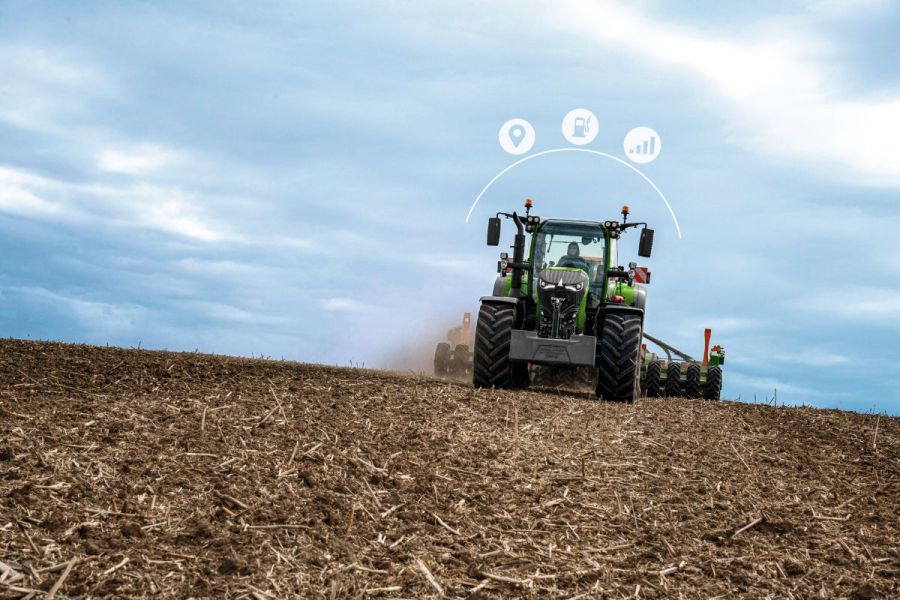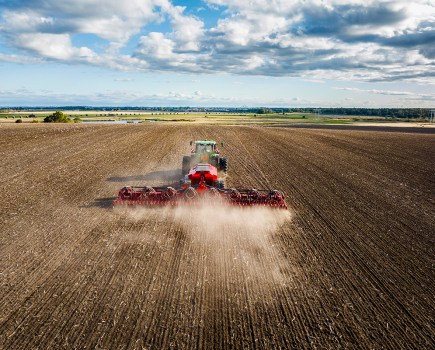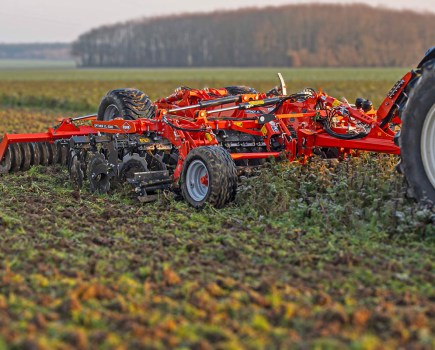Smart technology comes in many forms and so far as machine connectivity goes, it’s not just about collecting data, but about improving machine and farm performance across the board. CPM checks out some of the connectivity systems on offer.
“Having connected machines means moving away from reactive maintenance, towards preventative and proactive maintenance.”
By Melanie Jenkins
Increasing connectivity in tractors and other farm machines might seem like an added cost, or it could be perceived as an opportunity to improve operations. But one thing is for sure – connectivity is here to stay and it’s only going to become more integrated with farm operations.
Below are some of the different connectivity systems produced by key manufacturers, what these offer and how they can be of benefit on farm, as well as a breakdown of some upcoming launches.
Claas
Expanding its digital business is all part of Claas’ big picture for the future, explains the firm’s Rob Fillingham. “Our vision overall is to enable farmers to be the best in their field and for that to happen we have to embed our digital solutions in everything we do, whether it’s on the machine, in sales or the service process.”
But why is digital so important? “Connectivity from our point of view can be a huge time saver, whether it’s allowing the customer quick access to their data or making decisions from farm management data.”
Claas splits its connectivity system into three aspects: the on board Cemos steering system, telematics and the service system. Data such as service history, warranty and alarm messages can permissively be viewed by a dealership to improve machine maintenance. “We’re trying to make connectivity beneficial to everyone in the chain to help manage the performance of machines and improve customer uptime,” explains Rob.
In October last year, Claas introduced a five-year machine connect licence as standard for any machine from six-cylinders upwards. “Fundamentally this means having connectivity on the machine, which includes a hardware communication module that sends data to the Cloud.
“One of the key benefits of machine connectivity is it brings the firm’s telematics professional licence to all customers with the connectivity licence. In addition, they benefit from remote service whereby dealers can support machines in the field to reduce downtime, and it opens the doorway to send task data wirelessly to the machine,” explains Rob. “Claas also has application programme interface (API) partners such as Omnia, meaning task data can be sent straight to its Cemos terminal in its machines.”
Going forward, telematics will be built into the firm’s new system, Claas Connect, which will be available through a web portal and a mobile app due to go live in October.
Although wireless data transfer could previously be sent through the telematics platform, in future it’ll be accessible through Claas Connect. Task data can be sent wireless to the Cemos terminal in the cab and includes elements such as field boundaries and reference lines. “Existing telematics and machine data will be automatically transferred to the Claas Connect portal and customers will be prompted to make the switch,” says Rob.
The Claas Connect portal will also provide access to operator manuals and training videos – all serial number specific – as well as machine data and a digital handover process for machine purchases to reduce paper use. There’ll also be a tool to manage connections to third party software providers such as Gatekeeper, and access to a Claas parts catalogue and shop.
Machine data will include location, tracks and point data such as yields, says Rob. “But further analyses and interpretations are undertaken through Claas’ Farm Connect, Fleet Connect and Field Connect which require additional licences.
“The future aim is for Claas Connect to become an owner’s single point of entry to the Claas digital world, providing access to all information required to support their machines,” says Rob. “Rolling out Claas Connect is really important as it opens the doorway for autonomy, helping to prepare customers and dealers for technology that’s just around the corner.”
Fendt
FendtOne Offboard portal works with newer generation tractors but also with older S4 tractors with the 25cm NT01 screen, explains the firm’s Peter Henson. “Offboard isn’t limited to brand new tractors but can be used with older ones as well.”
In new tractors, the online Offboard portal is mirrored within the tractor’s display so that users will see tiles for the machine, fields, Map+, a task creator as well as task reports and team members, plus ‘how to’ videos.
Under the machine tile, users can see all Fendt machines as well as other implements. “If machines are on the telemetry, then there’ll be an overview of fuel consumption and working hours which users can click on to see greater detail such as alarms, service history, warranty and documentation,” says Peter.
Live tractor location updates are available and a link to the telemetry website allows users to access further information. Tractors can also be linked to a specific driver and implement information can be recorded in the system manually or through a transfer from the tractor. “The idea is to build a database so as we continue with data capture, there’ll be a standardised naming of implements to aid aspects such as guidance,” explains Peter.
The fields section of Offboard creates a database of the farm in one place where conflicts between data from different tractors can be assessed and updated, and this can then be transferred back to the fleet.
The task creator allows customers to create a task and send this to the tractor, while the reports section displays completed tasks and all details relating to these in completion order. A failsafe is in place so that if data can’t be wirelessly transferred, operators can do so manually via a USB. “Customers can see when a job was started and completed, where it was done, how much fuel was used, and if the implement has ISOBUS connectivity this data will be available too,” says Peter.
Users can also create heat maps, assess application rates, working width, tyre pressure, wheel and engine speed in the Map+ feature. Information can be imported from and exported to API systems, as well as being downloadable in different file formats for more in-depth analysis.
Customers can expect to see some upgrades later this year with changes to the fields tab to allow for zooming in on fields and the ability to manually draw boundaries. “At present, the boundary is only as good as Google Maps is, so users will soon be able to draw these themselves to help operators work more effectively. We’ll also be implementing the ability to import variable rate maps which can then be transferred to machines.”
In addition, the live tracking feature will be expanded to allow customers to see tractor movements up and down a field as they happen, details Peter. “Fendt will also be introducing a field data converter later in the year so that customers with mixed fleets will be able to import file types from competitor brands via USB.”
John Deere
Connectivity from John Deere comes in the form of JD Link, either through a premium R modem or a standard M modem fitted to a machine, with the former providing machine sync in addition to other shared features, explains the company’s Dennis Schrijver. “JD link records machine speed, direction of travel and fuel consumption, as well as sending error codes to the dealer to improve operations.”
Updates are pushed through automatically so customers don’t have to do this manually, and according to Dennis, this helps to cut costs. “JD Link also allows for remote access so that with permission, mechanics can view the tractor’s display remotely and talk to the customer to try and fix any issues quicker than having to visit the machine. Because dealers can see error codes before a machine breaks down, they can be proactive – it’s all about support through connectivity.”
And for customers running Gen 4 and Gen 5 displays, data can be wirelessly transferred between machines.
Via John Deere’s Operations Center, customers can see the live location of machines as well as monitoring their idle or in use time. “This is especially useful for bigger fleets as it helps to determine driver efficiency and which machines are most expensive to run,” says Dennis.
Both John Deere and other manufacturer’s machines with a JD Link modem can be added to the Operations Center, where fuel performance and history can be accessed and customers can dive deeper into data to assess machine and implement performance, he explains. “Contractors can utilise this not just for their own use but also to prove to a customer that a field has been worked.”
Data can be exported to a PDF or Excel file, and can be sent to or from connected API software. “This allows users to send machine performance data to their farm management software if they wish,” adds Dennis.
The portal can also be used to provide directions to a machine or field, either for other drivers or for mechanics, making it easier to find machines when they’re away from the main farmyard, explains Dennis. “It’s also possible to set maintenance plans to streamline services with dealerships but this is all only accessible with permission from the owner.”
Field analyser allows customers to view field size and boundaries, as well as record work which has been carried out in that field, such as tillage, spray applications and even moisture and yield records at harvest.
Most of the accessibility of the web portal is also available via a mobile app however, although the functionality is the same there’s a little less analysis available, highlights Dennis.
“Connectivity is allowing customers to get more out of their products while optimising fleet management,” he says. “It’s about saving time and money, as well as receiving active support when its required and being proactive with machine maintenance to improve uptime.”
New Holland
For New Holland there are two aspects to its connectivity system; what it includes and who it’s benefitting, says the firm’s Tom Mead. “Our end goal with connectivity is for it to benefit end users by improving interactions between customers and the dealer to reduce downtime and increase uptime.
“Having connected machines means moving away from reactive maintenance, towards preventative and proactive maintenance,” he points out. “The initial benefit for the dealers is that it reduces visits by the mechanic as the sensors and telematics can be accessed through remote access and screen sharing. And when the mechanic does attend the machine, they’ll know exactly what has to be done and can take the relevant parts.
“Farmers are also becoming increasingly busy; working is smaller weather windows and machines are becoming more expensive and more relied upon. So if a machine is sat idle for hours during prime moving hours, there’s potential for improvement, but without connectivity you might not know this.”
Through the MyNewHolland and MyPLMConnect (Precision Land Management) portals users have been able to add and monitor their machinery, download operator manuals, access online support and training, assess productivity and performance and evaluate agronomic and farm information.
But from the end of June, there’ll be some big changes for the system as it moves over to a new combined web portal and app under the FieldsOps heading. “This will bring with it all the core functions of the previous iteration, with access to all machines, telematics, parameters, error reporting, history and fleet management but streamlines this for a better end user experience,” says Tom. “Users won’t have to transfer any data but will just have to log in to the new system, and will be able to continue using the old portal for some months during a transfer phase.”
Features such as live machine tracking will be updated so that instead of data being pushed through every 10-20 seconds, users will be able to monitor machines on a second-by-second basis, he adds.
Customers will also be able to integrate their farm management software in FieldOps so their data is all in one place. “This’ll allow users to seamlessly send agronomic data to and from machines while jobs can be assessed and analysed via the portal – it’ll also provide a gateway for farmers to introduce variable rate maps.”
New Holland is also trying to push for greater API links to improve data transfer between platforms, says Tom. “We’re keen to see more integration with agronomists’ data to improve the transition of information to farm and vice versa.”
At present, any New Holland machine from the T5 up comes fully connected with a five-year licence, but for any machine (New Holland or otherwise) a CM1X modem can be purchased and retrofitted to provide connectivity via New Holland’s portal.
While New Holland currently runs a subscription plan for its connectivity service, this will soon be a thing of the past the firm has seen the widespread benefits of the system for its customers, its dealerships and for itself, says Tom. “Machines will soon be delivered with a lifetime connection because the uptake has been so successful and positive.”
Valtra
Although AGCO has a common system across its brands, Valtra was the first to release Connect on its machines at LAMMA in 2019. So what’s Connect capable of and how can customers get the most from it?
The system consists of web and mobile apps that allow users to see where their fleet is, so activity can be monitored in real time, explains Valtra’s Andrew Humphry. “Using Connect, it’s possible to see when tractors require refuelling, their fuel efficiency, working hours, idle and down time as well as comparing them with other machines in the fleet.”
The system can also be used to provide proof of work whereas the live location capability offers peace of mind when operators are working remotely, says Andrew. “It also has a curfew function, so if tractors are moving outside of their set operating hours, an alarm will go off on the owner’s phone via the Connect app. Alerts can also be set for fields or specific boundaries but it’s important to note that this isn’t a security feature, but instead a tool for the owner’s management.”
Connect also helps to streamline and improve dealer support as the dealership can digitally see when a tractor will require a service and book it in with the customer, rather than the customer having to keep track, he adds. “And because machines are becoming increasingly technical, it’s important to keep software updated via a technician.”
Dealers are also able to receive alerts for issues such as low oil pressure, and if this isn’t actioned, the dealer can proactively contact the customer to organise fixing the problem to help prevent greater costs down the line, says Andrew. “This is all about building the relationship between the dealership and the customer and to create a more streamlined system.”
Connect was first launched on the N and T series tractors but is now on the G, Q and S series, furthermore, any of these models can be retrofitted with the modem and display to enable connect if they didn’t have it pre-installed, he says. “Valtra is working towards making Connect standard across the lower horsepower tractors it produces as the technology becomes more popular.”
This article was taken from the latest issue of CPM. For more articles like this, subscribe here.
Sign up for Crop Production Magazine’s FREE e-newsletter here.




